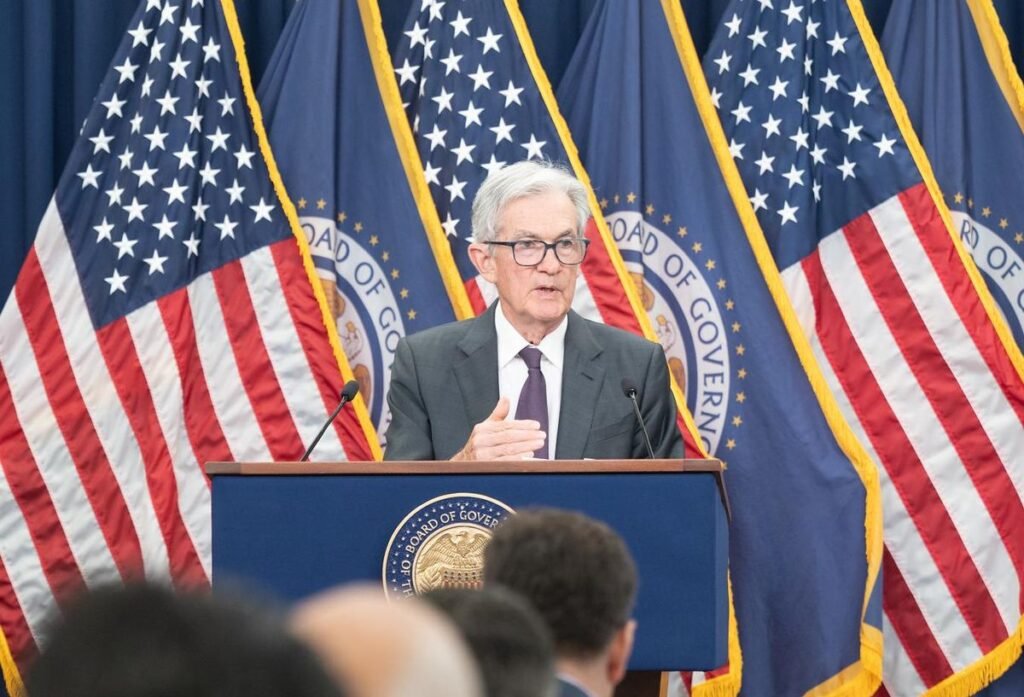The Federal Reserve cut interest rates for the second time in as many months, easing monetary policy just as commercial real estate markets snap back to life.
The widely expected decision gives investors an added piece of macroeconomic clarity as the government shutdown drags into its fourth week and the White House digs in on the trade war that kicked off in April.
It will also help moderate yields for 10-year Treasury bonds, which fell below 4% ahead of the Fed meeting. The yield, a common benchmark for commercial real estate debt, also slipped to just above 4% ahead of last month’s Fed meeting before climbing back above 4.1% in early October.

Federal Reserve Chairman Jerome Powell answers reporters’ questions after the central bank’s July meeting.
“The 10-year Treasury breaking below 4% is a momentary gift: Financial conditions are loose enough for borrowers to favorably refinance and mitigate interest rate risk,” Chris Stanley, banking industry practice lead at Moody’s Analytics, said in an email.
The vote to cut rates was contentious, with all but two members supporting the 25-basis-point cut that puts the federal funds target rate between 3.75% and 4%.
Stephen Miran, who was appointed by Trump and joined the Federal Open Market Committee last month, voted to cut the Fed funds rate by 50 basis points. Jeffrey Schmid of the Federal Reserve Bank of Kansas City, a rotating member of the FOMC, voted to keep rates flat.
The vote marked the third straight meeting with divisions among Fed officials, but the first where members split both in favor of a larger cut and in favor of no change at all.
“In the committee’s discussions at this meeting, there were strongly differing views about how to proceed in December,” Fed Chairman Jerome Powell said after the decision was announced. “A further reduction in the policy rate at the December meeting is not a foregone conclusion — far from it.”
Powell — who has faced bruising political attacks as President Donald Trump and his allies pushed for rate cuts — and the rest of the FOMC have a mandate to maintain maximum employment and stable prices. The central bank is facing headwinds on both fronts and is operating with less insight into the economy than it usually has on hand.
The government shutdown that began Oct. 1 delayed the latest consumer price index report by roughly two weeks, but the CPI print eventually put inflation at 3%, up 30 basis points from the prior month. The pace of price growth jumped less than economists forecast, but it is well off the Fed’s longtime 2% target and moving in the wrong direction.
The shutdown also stopped the Bureau of Labor Statistics from releasing a September employment report, and the agency hasn’t collected any data in October. A model released this week from the Federal Reserve Bank of Chicago put unemployment at 4.3% in September, effectively unchanged from the prior month but up 20 basis points annually.
Inflation hawks argue that the Fed is moving too quickly to ease interest rates and risks further fueling inflation. Stanley said the Fed’s decision was a “tactical error,” with short-term rate relief offset by rising costs and volatility across the yield curve driven by swings in trade policy from the White House.
“Borrowers must use this temporary opportunity to restructure maturing debt and hedge against future volatility — because borrowing when you can, not when you need to, is the only path to maximizing operating income,” he said.
Commercial real estate transaction volume was already accelerating ahead of the Fed decision. Sales across sectors totaled $42B in September, up 19% from the prior year, according to MSCI Real Assets.
Office sales were up 42% at the halfway point of the year, and U.S. office vacancy declined in the third quarter for the first time since 2019 as companies execute on postpandemic strategies and older buildings are converted to apartments.
With Wednesday’s decision, the Fed has now cut the target federal funds rate by 150 basis points over the last year. The cumulative effects of the shift in monetary policy are making their way through capital markets, said Dan Berman, managing partner in the real estate practice at Herbert Smith Freehills Kramer.
“The cut may not dramatically change transaction volume overnight, but it strengthens the sentiment that’s been driving activity, proving that we’re finally operating in a more constructive, stable environment,” he said in an email.
This is a developing story.

